Subscribe to Zero-Sum Pfear & Loathing


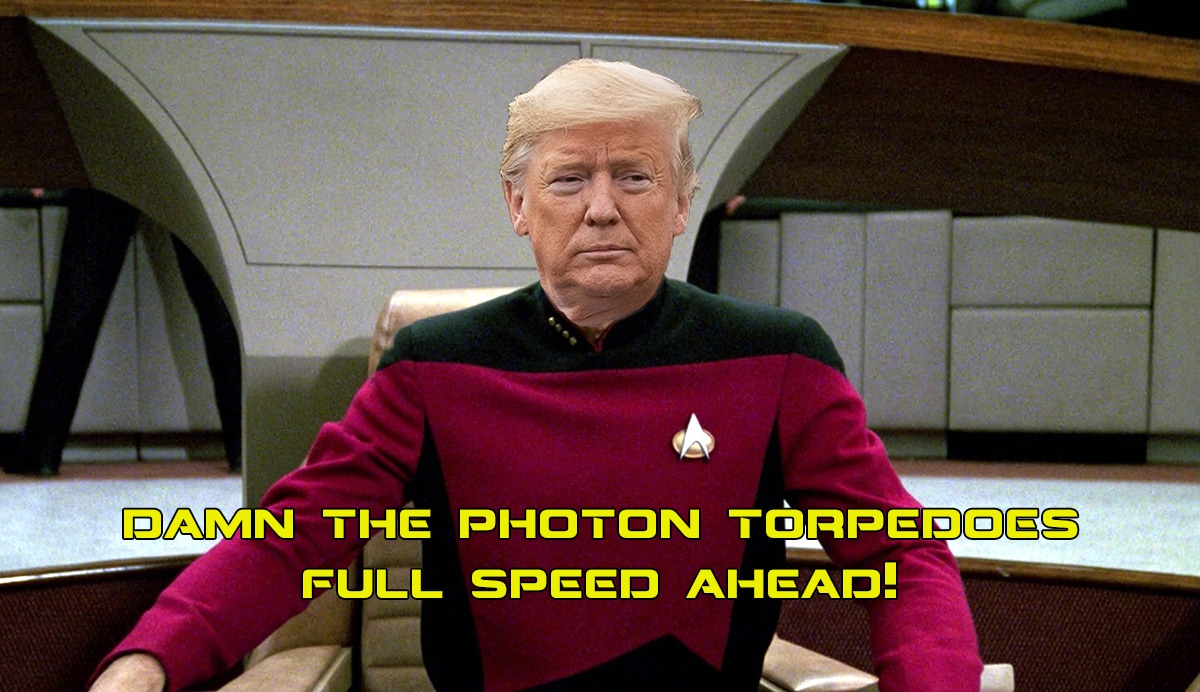
Oh no! The coronavirus narrative is beginning to fall apart! Even Dr. Fauci claimed that we are out of the pandemic phase. He hedged that comment a couple of days later. But that’s what the coronavirus narrative has come to—hedging and equivocation. What happened to the bold, enthusiastic James T. Kirks and Jean Luc Picards who would, despite waning vaccine efficacy, destroy the virus forever and take us where no one has has gone before? Health leaders seem to have abandoned the truth that all coronavirus strategies and all calls to action must be rooted in the only future we can conceive—Star Trek.
A recent Wall Street Journal article, BA.2 Proves the Pandemic Isn’t Over, but People are Over It, essentially concluded, “if this is a pandemic wave, then many people have decided the best response is a weary shrug.” This outrage can only be attributed to intellectual lethargy. Rather than assigning COVID variants names evocative of dangers brilliantly resolved in Star Trek episodes, lazy bureaucrats have taken to giving them letters and numbers!
What are BA.2, BA.3, BA.4, BA.5? Third rate degrees from online universities? Preferred double-masked seats on British Airways flights? Where’s the danger? Where is the fear of the unknown?
The XE variant is equally unthreatening in its name. It seems to be styled after a four-door Jaguar sedan. If variant namers wanted to evoke Jaguar, they should at least have called the variant XKE—fast and dangerous.
Whatever one thinks of Donald Trump, it cannot be denied that he had an extraordinary sense and command of fiction, especially popular fiction. He knew that he could evoke Star Trek imagery to justify the cost of military expansion into space to an overwhelmed citizenry when he unveiled the new U.S. Space Force logo.
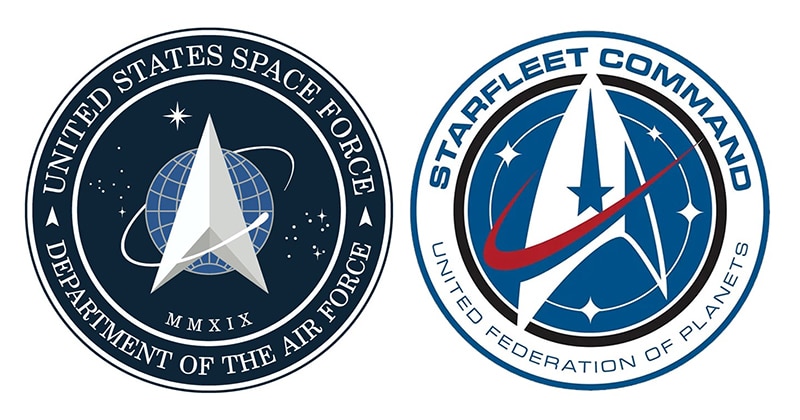
In early 2020 billions of people were dying from or with COVID-19. Health officials everywhere knew that they had to rapidly develop a vaccine before the disease could run its course. They were also concerned that, using normal safety protocols, vaccines from the past took up to 10 years to develop. They needed a vaccine from the future. Once again Star Trek showed them the way.
Armed with new mRNA genetic modification vaccine technology and computer-proven efficacy, health officials had to justify expedited human trials with another trope from the future.
Once again Mr. Tump’s vast knowledge of popular culture proved invaluable. He knew that warp drive, the main propulsion system for most Star Fleet vessels, was capable of faster-than-light travel—Warp Speed.1
Operation Warp Speed was born and the public understood that vaccines were coming fast, really fucking fast.
Since Star Trek the Next Generation, the Delta Quadrant2 was known to be the home of the Borg, the deadliest species known to human kind. It should also follow that the Delta variant, the deadliest virus, likely came from the Delta Quadrant. To convey the threat that the variant could kill billions more people, our health leaders named the variant appropriately.
To encourage large scale vaccination, our health leaders briefly considered using the Borg hail, “resistance is futile,” but instead mandated vaccines for large segments of the population.
Shortly after 7-of-9 was liberated from the Borg and her connection with the hive mind was severed, she was confused, inconsolable that she was alone. Captain Janeway reminded her, “Your mind is independent now with its own unique identity.”
Later, again questioning the limitations of individuality, 7-of-9 pointed out an advantage of Borg assimilation of millions of cultures—assimilation of vaccines and immunity.
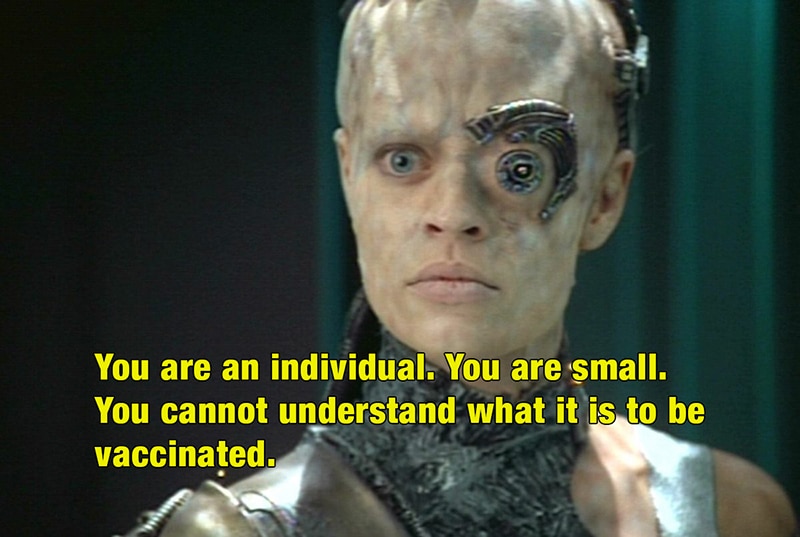
In the Star Trek original series episode, This Side of Paradise, an otherwise Class M world, was targeted for a 23rd century agricultural colony until its primary star, Omicron Ceti, was found to emit fatal doses of Berthold radiation.
When the Enterprise crew arrived on the planet to ostensibly evacuate the colonists, they found that the radiation did not effect the colonists at all. Instead the colonists seemed to be content, happy with their situation and unwilling to evacuate.
As the Enterprise landing party interacted with the colonists, the crew members. one by one, became deliriously ecstatic—stoned. They began to neglect their duties, instead wandering the fields on the colony and communing with nature like 1960s hippies. Spock lost his Vulcan non-emotional veneer, and fell in love!
Spock discovered that non-native plants acted as a repository for thousands of microscopic spores until they found a human body to inhabit. In return, they gave their host complete health and peace of mind and protected their hosts from the effects of the Berthold radiation.
The entire Enterprise crew, lured by joy, beamed to the surface of the planet and left Captain Kirk alone on the ship with a mutiny on his hands. After Kirk accidentally inhaled spores from a plant left on the ship, he decided to join the community, but his anger and frustration at leaving the ship broke the spell of the spores.
Kirk surmised that anger was the only antidote to the effect of the spores and picked a fight with Spock to test his theory. Spock became so enraged that he almost killed Kirk, but snapped out of his euphoria. To restore order, Kirk and Spock decided to provoke other crew members to rouse them from their trances. Many brawls broke out on the planet, the spores’ effects subsided, the crew returned to normal and the colonists were evacuated.
We must understand the lessons of Omicron. While Omicron might be milder, we may not be so lucky with its various variants. We cannot be lulled into complacency or persuaded by anti-vaxxer, misinformationist calls for utopian, self-healing community to replace an all out war against a deadly virus. We must duke it out like Captain Kirk to maintain order and rationality.
On July 12 2266, Captain Kirk and Mr. Spock beamed down to the surface of planet Organia to negotiate for the establishment of a Federation base on the planet, due to the its strategic location. Hostilities between the Klingon Empire and Federation had reached alarming heights and it was feared that the medieval culture of the Organians will not be able to withstand a Klingon attack.
The Klingons arrived shortly thereafter to begin their occupation. Kirk and Spock, stranded on the planet, go undercover posing as Organian and Vulcan traders. When Kirk and Spock met the new Klingon Military Governor Kor, he looked relatively human.

By 2363, in Star Trek the Next Generation, Lieutenant Worf joined the Enterprise crew as the only Klingon serving in Star Fleet. Less than a century from Kirk and Spock’s initial encounter with them, Klingon physical appearance had changed dramatically.
Clearly, interaction between Klingons and the Federation over almost a century produced cultural interchange that included medical advancements. In this case the highly vaccinated Federation3 shared that medical technology with the Klingons. The Klingons eradicated many stubborn diseases.
Due to the Klingon physiology, however, a peculiar anomaly appeared—the spikier protein, which strengthened Klingon bone structure, albeit changing their physical appearance over the years.
Modern Klingons have embraced the changes. Most Klingon warriors agree that their augmented appearance makes them much more intimidating than their ancestors and that the increased bone density makes them less injury prone. They say spikier protein is an anomaly they can celebrate, much less than simply endure.4
Anti-vaxxer “scientists” claim that myocarditis can be a side-effect of COVID-19 vaccination. While this is patently false, even if it were true, myocarditis is simply another anomaly that can be assimilated and controlled.
Any Star Trek fan knows that soon after Jean Luc Picard graduated from Star Fleet Academy, he and two of his friends, Cortan Zweller and Marta Batanides, started a bar fight after a trio of Nausicaans cheated during a game of dom-jot. During the melee, one of the Nausicaans stabbed Picard through the heart with a Nausicaan sword, severely injuring him, necessitating the implant of an artificial heart.
Technology did not fail Picard as he commanded the Enterprise, nor did it fail him his entire career, as he eventually ascended to the rank of Admiral Picard. Even in his eighties, Picard was fit enough to travel back in time to negotiate an alliance with a future Borg queen in order to save the universe of his time.

Nor will technology fail to serve those who may have suffered myocarditis from imagined vaccine injury. In the near future we will be able to print new hearts for those who may have myocarditis. That’s not a hope but a promise from a future as bright as the promise of Star Trek. You can count on us!
Yes, when exploring new worlds and going on missions of scientific discovery, anomalies are all in a day’s work for our trusted health leaders.
The World Health Organization’s recent decision to rename monkeypox virus is long overdue. Monkeypox has strained the credibility of our health leaders since it emerged as a topic of discussion months ago. Did one have to fornicate with a monkey to contract the disease? Or just have monkey contact? The idea of a monkeypox virus spawned various articles and memes that made the WHO and other truly concerned professionals laughing stock.
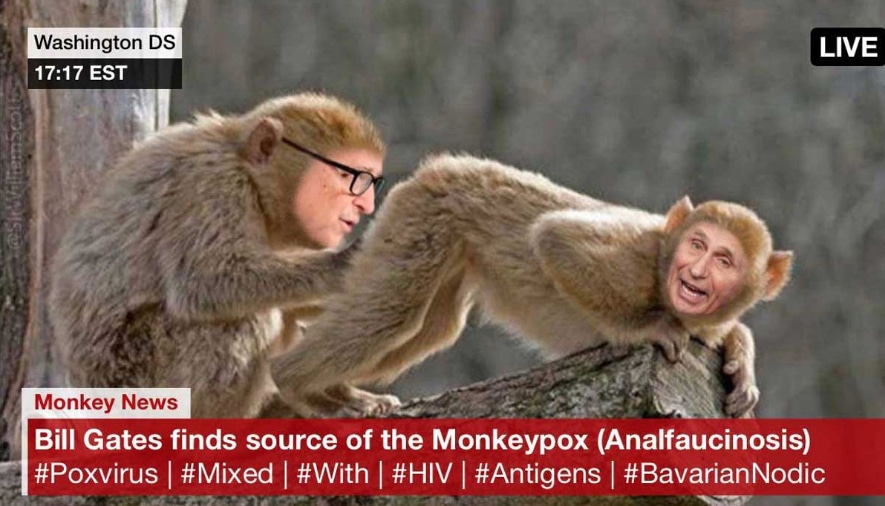
Once again, lazy bureaucrats failed to drop the shock and awe ball by forgetting to brand the disease as a deadly space plague. Monkeypox, as a brand, would never capture the public imagination as long as it was associated with our cute little cousins that have captivated and entertained us since the pharaohs of Egypt kept them as pets and honored them at burial with mummification.
Dr. Tedros Adhanom Ghebreyesus recently announced that the WHO would change the name of the monkeypox virus, its clades.5 and the diseases it causes.
The WHO will officially rename monkeypox over concerns of stigma and racism surrounding the virus that has spread to more than two dozen countries, @DrTedros says https://t.co/MKz4mXDwkx pic.twitter.com/hG0NuC2MTG
— Bloomberg Quicktake (@Quicktake) June 14, 2022
This is the perfect time to expand the scope and the global outbreak of this disease “which is unusual and concerning.” Recalibrate the PCR tests and bring it on!
In Star Trek Voyager, The Phage((“Phage” is short for bacteriophage. The term “phage” itself literally means “to eat.” A bacteriophage is a virus that reproduces within a bacterium – it infects bacteria by attaching a hollow protein tail to a bacteria cell wall, injecting DNA (or sometimes, RNA) into the cell. Bacteriophages live at the expense of the bacteria they inhabit, and in most cases eventually kill their bacterial hosts.)) was a disease that afflicted the Vidiians, killing thousands daily for approximately 2,000 years. The disease was highly adaptive to nearly every new form of medical treatment, and adapted so fast that their “immunotechnology could not keep up.” It consumed the Vidiians, at first disrupting their genetic code, then devouring their body tissues and destroying cellular structures. One of the early symptoms of the disease was excruciating joint pain. Some victims had been known to die simply from the agony itself, and euthanasia of afflicted persons was common.
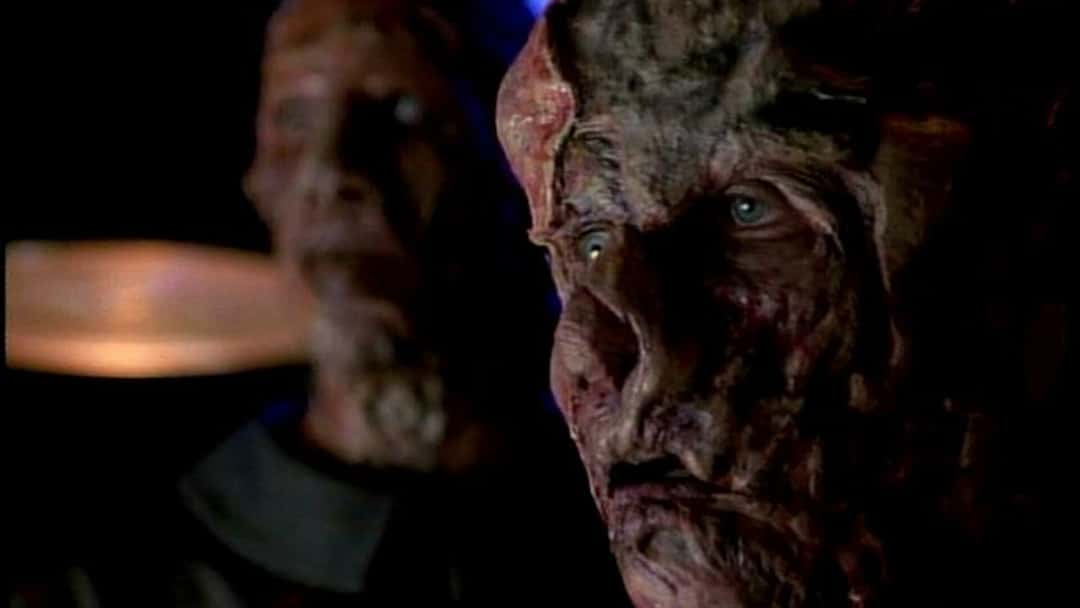
The Phage—final stage
The Vidiians survived in the short term by making extensive use of transplantation and organ piracy, using transporter technology to extract usable organs from cadavers, but eventually began using it to literally steal healthy organs from the living.6
Now this is a disease into which the World Health Organization can sink its teeth!
Notably, Dr. Tedros expressed a desire to not only change the name of the monkeypox virus but also to change the names of the diseases which it causes. Hopefully the WHO will get back on track and take the opportunity to rebrand the disease as The Phage, recognizing that the successes of the the initial pandemic response were rooted in Star Trek branding.
To that end, our partners and stakeholders at Johns Hopkins Bloomberg School of Public Health have already produced an online advertisement to encourage the WHO to do the right thing.

As the Wall Street Journal implied, without Star Trek, pandemic apathy could undermine our carefully conceived and controlled coronavirus narrative. Our creation of a new pathogenic society could be stopped in its tracks unless the WHO wises up. The WHO must understand that the public knows and loves Star Trek. Consequently, the public will know and love the WHO when it fully embraces a Star Trek vision of the future.
References
Wholly unexplored until word was received in 2374 from the lost U.S.S. Voyager. Compressed messages from the ship, long presumed a casualty, detailed its accidental arrival there and travels homeward among cultures such as the Kazon sects, the Vidiians, Talaxians, Ocampa, the Hirogen, Species 8472.
Fiction fact-checkers may disagree, pointing out that Klingons had their head ridges in Star Trek Enterprise and Star Trek Discovery. We adamantly disagree with the so-call Kelvin Timeline in this respect. Star Trek the Original Series encountered the Klingons first. Attempts to alter Klingon appearance in new iterations of Star Trek set in earlier time periods than the Original have failed. Notably, Star Trek Discovery had to catapult 900 hundred years into the future to correct the plot flaws of spore drive and, presumably Klingon appearance. Luckily, as of this writing, we have yet to see a Klingon on Star Trek: Strange New Worlds.
A clade consists of an organism and all of its descendants. For example, the shared ancestor of apes and all of that species descendant species would comprise a “clade.” The term “clade” comes from the Greek “klados,” for “branch.” It’s useful to think of a clade as being one “branch” on the tree of life, where the common ancestor is the place that the branch split from the main trunk. Because clades are a way of thinking about “branches of the tree of life,” a clade can only contain organisms that do share a common ancestor. A clade also contains all descendants of that branch, excluding none.
“Phage” is short for bacteriophage. The term “phage” itself literally means “to eat.” A bacteriophage is a virus that reproduces within a bacterium – it infects bacteria by attaching a hollow protein tail to a bacteria cell wall, injecting DNA (or sometimes, RNA) into the cell. Bacteriophages live at the expense of the bacteria they inhabit, and in most cases eventually kill their bacterial hosts.